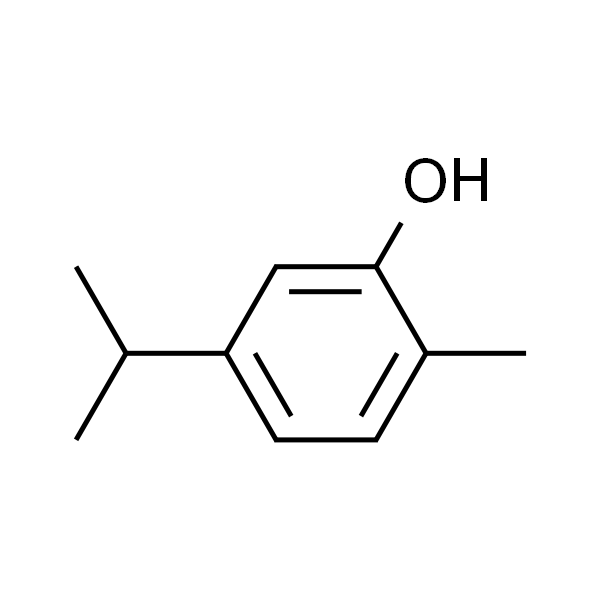Carvacrol;香荆芥酚
货号:
IC1310
品牌:
Jinpan

暂无详情

暂无详情
产品简介
| MDL | MFCD00002236 |
| EC | EINECS 207-889-6 |
| 描述 | 密度:0.976?g/mL |
| InChIKey | RECUKUPTGUEGMW-UHFFFAOYSA-N |
| InChI | InChI=1S/C10H14O/c1-7(2)9-5-4-8(3)10(11)6-9/h4-7,11H,1-3H3 |
| PubChem CID | 10364 |
| 别名 | 香麝香草酚;5-异丙基-2-甲基苯酚 |
| 英文名称 | Carvacrol |
| CAS | 499-75-2 |
| 分子式 | C10H14O |
| 分子量 | 150.22 |
| 纯度 | HPLC≥98% |
| 单位 | 瓶 |
| 生物活性 | Carvacrol (Cymophenol), monoterpenic phenol isomeric with thymol, has diverse activities such as antimicrobial, antitumor, an-timutagenic, antigenotoxic, analgesic, antispasmodic, anti-inflammatory, angiogenic, antiparasitic, antiplatelet, AChE inhibitory, antielastase, insecticidal, antihepatotoxic and hepatoprotective activities.[1-2] |
| In Vitro | Carvacrol (CVC) possesses weak antioxidant and cytotoxic activity in cultured primary rat neurons. In addition, Carvacrol has weak antioxidant properties and little anticancer potentials in rat N2a neuroblastoma cell line[1]. Carvacrol is a novel inhibitor of transient receptor potential (TRP) channels in drosophila and mammalian. In human hepatoma HepG2 cells, Carvacrol induces cell apoptosis by selectively decreasing phosphorylation of extracellular signal-regulated kinase 1/2 (ERK1/2) and P38; In human macrophage-like U937 cells, in response to lipopolysaccharide treatment, Carvacrol activates peroxisome proliferator-activated receptors (PPAR alpha and gamma) and suppresses cyclooxygenase-2 (COX-2) mRNA and protein expression[2]. |
| In Vivo | Carvacrol has the ability to protect liver against ischemia/reperfusion injury in rats. In the central nervous system, Carvacrol is regarded as a potential drug for Alzheimer’s disease due to its inhibitory effect on acetylcholinesterase (AChE) activity by using phenolic hydroxyl group of carvacrol to bind to AChE and leading to a loss of function of AChE. In addition, Carvacrol is found to have an antidepressant-like effect in mice by affecting the dopaminergic system. Dietary carvacrol supplementation prevents high fat diet-induced obesity by modulating gene expressions that lead to adipogenesis and inflammation. Carvacrol crosses the blood-brain barrier easily and rapidly[2]. |
| SMILES | CC(C)C1=CC(O)=C(C)C=C1 |
| 靶点 | Apoptosis;Notch;Others |
| 动物实验 | Animal Models: Male ICR mice; Dosages: 50 mg/kg; Administration: i.c.v.[2] |
| 细胞实验 | The cells are seeded in 48-well plates. Cells are incubated at 37 °C in a humidified 5 % CO2/95 % air mixture and treated with carvacrol at different concentrations (10, 25, 50, 100, 200 and 400 mg/L) for 24 h. MTT substrate solution is used. Briefly, MTT is added to the cell cultures for 3 h. Formed formazan crystals are dissolved in dimethyl sulfoxide (DMSO), MTT is added to the cell cultures for 3 h. Formed formazan crystals are dissolved in dimethyl sulfoxide (DMSO).[1] |
| 数据来源文献 | [1] Elanur Aydın, et al. Cytotechnology. 2014, 66(1): 149–157. [2] Yu H, et al. PLoS One. 2012, 7(3):e33584. |
| 规格 | 20mg 100mg 200mg |
Carvacrol 是唇形科植物中的单萜酚类,具有抗氧化、抗炎、抗癌活性。Carvacrol 可导致 G0/G1 细胞周期停滞,下调 Notch-1 和 Jagged-1,诱导凋亡。
